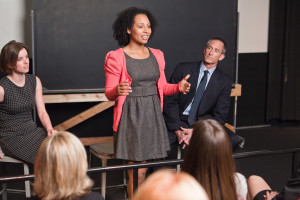10 REASONS WHY MOST PRESENTATIONS FAIL
10 REASONS WHY MOST PRESENTATIONS FAIL
By BARBARA MOYNIHAN
One way to raise the profile of your business is to seek opportunities to speak in public. These could be anything from a slot at a lunch time networking group to a keynote speech at a trade conference.
Overall the standard of public speaking is not as high as it could be and many presentations fail to hit the mark. The last thing you want is that you fail to impress and put prospects off.

So why do presentations fail and how do you avoid these pitfalls and stand out from the crowd?
- Lack of rapport. Make sure you talk in terms of your audience’s interests. Smile, start on time, dress appropriately for the occasion and ensure you finish on time.
- Being unauthentic. Take the time to prepare, practice and just be yourself. Try recording yourself on your phone to help you become familiar with your content and look for areas to improve how you sound. For a significant presentation you may even video yourself to improve how you look as well as sound.
- Inability to use silence. Use pauses to add impact and emphasise your key points – silence speaks volumes.
- Lack of facial expression. We have 80 muscles in our face that are capable of producing 7,000 facial gestures. Engage them and engage your audience.
- Poor eye contact. How many talks have you been to where the presenter is merely reading from PowerPoint slides? If you have to use slides, make sure they add value and aren’t just a crutch. Look at, and visually connect, with members of your audience.
- Tech-talking. Do not bore your audience with technical details that they do not need. Simplify your message. Avoid Three Letter Acronyms (TLAs).
- Lack of humour. You don’t have to be a stand up comedian. If you cannot tell a joke – then don’t. Use alternative methods of humour such as anecdotes, relevant pictures or short movie clips. YouTube is a great source of content on virtually any topic.
- Lack of direction. Ensure you have a clear structure to your speech with a beginning, middle and end, with appropriate signposts and transitions to keep your audience on track.
- Lack of energy. Counteract this by projecting your voice, varying your pace and pitch, and using gestures.
- Boring Language. Use what performance story teller, and Toastmasters champion Andrew Brammer (www.speakingwords.co.uk) calls “linguistic sparklers”: adjectives, adverbs, and rhetorical devices such as metaphors and similes.
Whether you want to raise your business profile through public speaking, or simply want to motivate your team to take on new challenges, investing some time in developing your speaking skills will pay handsome dividends.
Speaking clubs such as those run by Toastmasters International are an ideal environment to try out your talks, learn new skills and get constructive feedback to make sure that when you do stand up, you and your business will be noticed for the right reasons!
To find your local Toastmasters Club see: www.toastmasters.org
About Barbara Moynihan:
Barbara Moynihan is Past President, Toastmasters International (Dun Laoghaire club)
and founder of On Your Feet, a Communications Training Company based in Dublin www.onyourfeet.ie
About Toastmasters International
Toastmasters International is a nonprofit educational organization that teaches public speaking and leadership skills through a worldwide network of meeting locations. Headquartered in Rancho Santa Margarita, California, the organization’s membership exceeds 292,000 in more than 14,350 clubs in 122 countries. Since 1924, Toastmasters International has helped people of all backgrounds become more confident in front of an audience. There are over 250 clubs in the UK and Ireland with over 7000 members. To find your local club: www.toastmasters.org Follow @Toastmasters on Twitter
